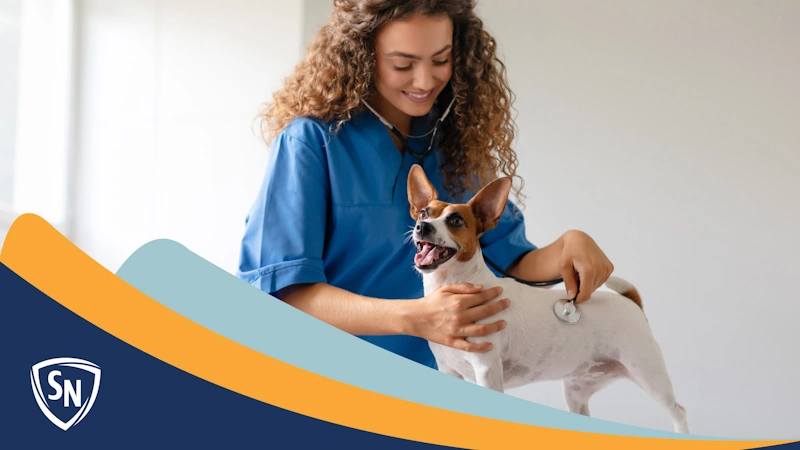
If you’re an animal lover who’s been thinking about stepping into the veterinary field, a veterinary assistant program could be the perfect way to begin. These programs are short, hands-on, and designed to get you working quickly. As a veterinary assistant, you’ll support veterinarians and veterinary technicians with animal handling, exams, lab work, and everyday care tasks. You might also find yourself at the front desk, helping pet owners navigate appointments and treatments.
Veterinary assistants work in clinics, animal hospitals, emergency vet offices, and shelters. Whether it’s calming an anxious pup, sterilizing tools, or explaining post-op care to a nervous owner—you’ll become a quiet force in keeping animals safe and cared for.
The training itself is usually quick—often just 6 to 12 months from start to finish.
Want to see veterinary assistant programs near you? Click here
What You’ll Learn in a Vet Assistant Program
Below are some of the most common courses you’ll take in a veterinary assistant program.
Introduction to Veterinary Science
This foundational course introduces you to the world of veterinary medicine. You’ll explore essential terminology, medical ethics, legal guidelines, and the primary responsibilities of a veterinary assistant. It also covers basic animal care, safety procedures, and how to manage infection risks in clinical settings.
Animal Anatomy and Physiology
You’ll study how animal bodies work—inside and out. This includes bones, muscles, organs, and body systems like the digestive, respiratory, circulatory, and nervous systems. Expect to explore both small animal anatomy (cats, dogs, rabbits) and large animal anatomy (horses, cows, livestock).
Veterinary Pharmacology
This course covers medications commonly used in veterinary care. You’ll learn to identify drug types, understand interactions and side effects, and handle prescriptions with care. Topics like dosage calculation, storage, labeling, and disposal are included, giving you a solid grasp of medicine safety.
Clinical Procedures and Laboratory Assisting
This is where things get hands-on. You’ll learn to take vitals, collect samples (like blood, urine, or feces), run diagnostics, clean wounds, and assist with exams and procedures. You’ll also learn to use lab tools and sterilization techniques correctly.
Emergency Procedures and First Aid
When an emergency strikes, veterinary assistants often help stabilize animals until the vet takes over. This course covers animal CPR, bandaging, transporting injured pets, and recognizing symptoms like heat stroke, poisoning, and shock.
Veterinary Radiology and Imaging
Learn the basics of X-rays and imaging. You’ll study how to position animals, assist with ultrasound procedures, and follow radiation safety protocols. You’ll also learn how to support the vet in identifying broken bones or hidden issues through diagnostic images.
Surgical Anesthesia
In this course, you’ll prepare animals, equipment, and surgical rooms for operations. You’ll also study the basics of anesthesia monitoring, sterilization, and how to assist during surgery. The focus here is on support, safety, and preparation.
Nutrition and Preventative Care
Good health starts with good care. This course explores how proper nutrition supports animal health and how routine care—like vaccines, flea control, and dental hygiene—can prevent bigger problems. You’ll learn how to educate pet owners with kindness and clarity.
Veterinary Ethics
Here, you’ll step into the moral side of animal care. Topics include client confidentiality, informed consent, end-of-life care, and the emotional weight of decision-making in vet settings. You'll also review local and federal laws that govern the industry.
Clerical Office Duties
Beyond animal care, you’ll need to keep the clinic running smoothly. This course teaches scheduling, patient records, phone etiquette, and how to use veterinary software. You’ll become the calm voice on the line and the steady hand behind the desk.
Veterinary Assistant Externships
Most programs include an externship—real-world training at a clinic, shelter, or hospital. You’ll shadow experienced staff and put your classroom knowledge to work. Externships often lead to job offers or strong professional references.
Final Thoughts
Veterinary assisting is a heart-forward career for anyone who loves animals and wants to work hands-on. Courses may vary by school, but the spirit is the same: train well, care deeply, and help both pets and their people feel seen.
According to the Bureau of Labor Statistics, the field is projected to grow by 19% in the next decade—a rate much faster than average.
Ready to take the first step? Find a local program





